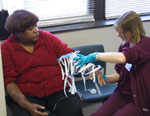YES Campaign dollars aid burn patients
by Chris WestPublic Relations
Last year marked a progressive step in the treatment of burn patients when YES Campaign dollars helped bridge the gap in the disparity of resources and care.
For physical therapy manager Erica Rouvalis, the grant couldn’t have come a moment too soon. “I think we spent it as soon as we received it,” Rouvalis said about the 2001 grant awarded her department. “The need we had warranted using the grant as soon as we could.”
The need in question was compression garments for adult burn victims. The solution would lie in a YES Campaign grant from the undesignated fund.
The YES Campaign is an annual fund-raising drive that allows employees to make a contribution to a fund of their choice within the MUSC Health Sciences Foundation. Some employees choose to contribute to the YES Undesig-nated Fund, which makes grants available to every clinical, research and academic departments within the university system. Since its inception in 1999, the YES Undesignated Fund has awarded more than $52,000 in such grants.
 Physical
therapy facilitator Amy Ferguson measures the arms and hands of burn victim,
Lorene Mack for compression gloves.
Physical
therapy facilitator Amy Ferguson measures the arms and hands of burn victim,
Lorene Mack for compression gloves.
“The garments facilitate the cosmetic and functioning aspects of burn treatment to provide the patient the best outcome,” she said. The suits are used to apply direct pressure to affected tissue of burn victims rendering it flat. This allows the burned area to heal in a more even and uniform manner minimizing or preventing deforming hypertrophic scarring. And while this treats the cosmetic aspect of a burn, it is also paramount in returning mobility and full range of motion to affected limbs.
“Previously we relied on the hospital to provide the garments for our patients, but this raised a question with the issue of compliance and we realized we couldn’t do things that way anymore,” Rouvalis said. “This left a large population of underfunded and limited funded adult burn patients with no way to receive the necessary standard of care to finish treatment of their injuries.” Prior to this change, there was already a large disparity between resources available to adult and child burn victims.
“Children burn victims have support networks and donated resources, such as Aluminum Cans for Child Burn Victims, to facilitate their care. Adults don’t have this community outpouring to facilitate theirs,” Rouvalis said.
And with no body of consistent funding for adult burn victims, they find themselves unable to afford the necessary treatments to fully treat their injuries and even for adults with insurance coverage, they find much of the treatment methodology not covered by their provider. Burn garments are especially costly to maintain in that patients utilizing this form of treatment must have two suits on-hand so that one may be cleaned while the other is being worn. In addition, an average suit’s life is usually only three months. All this for a method of treatment that typically lasts a year or longer.
So how does a physical therapy manager find herself going to bat for the burn unit?
“Physical therapy is a large part of burn treatment and it takes a lot of rehabilitation to return these patients to their previous level of function. The garments are an integral part of that treatment and we were simply trying to find a solution for this population while being cost-effective and without compromising treatment,” Rouvalis said. “All the while, trying to create some equity between children and adult burn victims.”
Rouvalis admitted that although the 2001 grant did provide some relief from the shortage of resources, there are still needs within the department.
“There will always be new patients with burns and while a number of patients benefited from the grant, there still remains a large population that has not been accommodated. This makes the hunt for other resources continuously ongoing,” she said. “That’s why we are seeking to renew the 2001 YES grant in hopes that it will again ease some of the financial burden for this population of burn victims.”
So are those all-valuable YES Campaign dollars making a difference?
For a number of adult burn victims faced with limited avenues to receive
much needed treatment—YES they are.